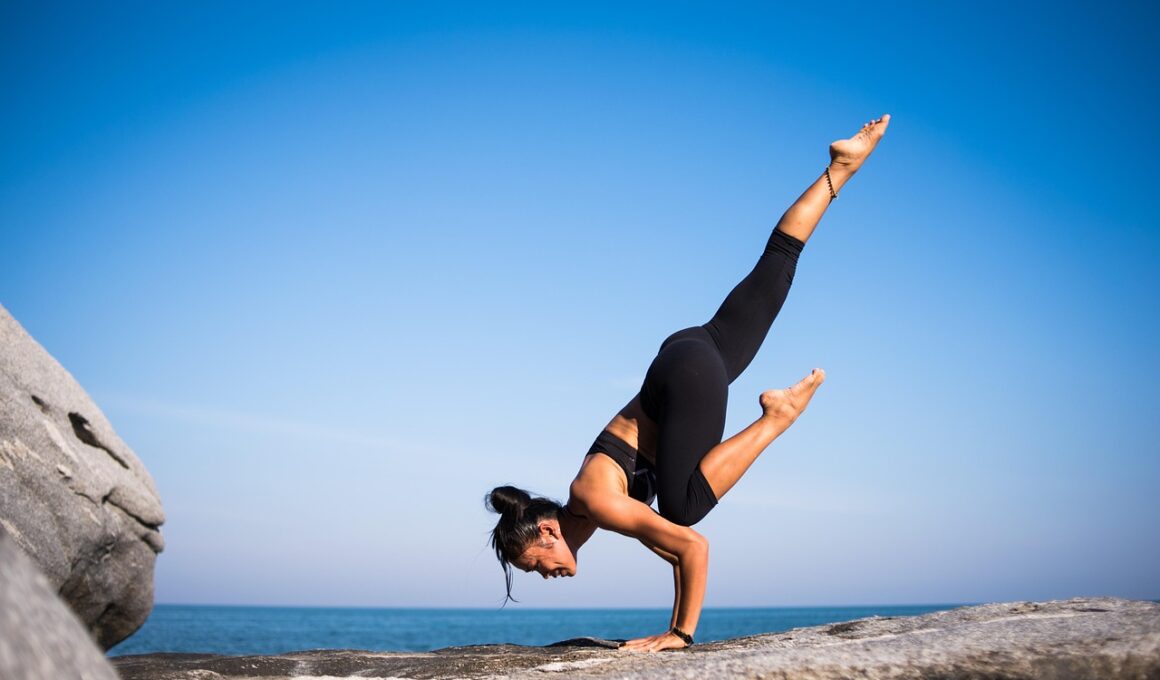How to Incorporate Yoga for Enhanced CrossFit Mobility
Combining yoga with CrossFit can profoundly improve mobility and flexibility while enhancing overall performance. Practicing yoga offers various dynamic stretches and postures aimed at increasing range of motion. Incorporating yoga as part of a CrossFit routine may help athletes recover faster, reduce the risk of injuries, and enhance overall muscle function. Yoga helps to alleviate tight muscles, allowing for smoother movements in workouts. This practice emphasizes mindful breathing, posture, and alignment, which can significantly benefit CrossFit athletes, where proper technique is essential. The challenge lies in committing time to the practice consistently. Setting aside even a short amount of time daily for yoga can produce remarkable results. Whether done before or after a CrossFit workout, yoga fosters a holistic approach toward fitness. Athletes should consider engaging with a certified instructor for specialized training, ensuring they receive correct guidance on breathing and alignment. Additionally, various online resources and apps are available to help practitioners optimize their yoga workouts. So, explore the incorporation of yoga to boost CrossFit prowess and witness an improvement in mobility, flexibility, and the overall workout experience!
Understanding the benefits of yoga can motivate CrossFit enthusiasts to embrace this practice fully. Many athletes often overlook mobility and flexibility, focusing primarily on strength and endurance. However, sufficient joint range and muscle flexibility are vital for optimal performance in CrossFit. When incorporating yoga, cross-training opportunities arise, enabling joints and muscles to adapt, recover, and thrive. Engaging in specific poses tailored for CrossFit athletes can enhance strength and stability. Key yoga postures such as Downward-Facing Dog, Cobra Pose, and Pigeon Pose can actively target commonly tight areas in athletes such as hips, hamstrings, and lower back. Regular practice will lead to noticeable increases in performance, such as improved lifting techniques and stroke efficiency. Furthermore, yoga reinforces mental resilience by cultivating a strong mind-body connection. This connection helps athletes stay calm, focus on their workouts, and maintain a positive mental attitude. By fostering this connection, athletes can better manage stress and anxiety during competition or training. Hence, the symbiotic relationship between yoga and CrossFit is substantial. Recognizing the potential benefits might encourage those involved in CrossFit to incorporate yoga practices into their weekly workout schedule.
The Importance of Mobility in CrossFit
For CrossFit participants, understanding mobility’s vital role is essential. Adequate mobility influences performance, reduces injuries, and enhances recovery. Consistent mobility work helps improve not only flexibility but also functional movement patterns, which are critical in CrossFit workouts. Combine this with yoga, and practitioners will witness a significant shift in their body’s adaptability. For optimal results, focusing on specific muscle groups most affected during CrossFit sessions is crucial. This includes large muscle groups like quads, hamstrings, and core muscles, while also targeting smaller, often neglected stabilization muscles. Integrating yoga strengthens these overlooked muscles through dynamic stretching and the activation of deep stabilizers. Even simple yoga flows can provide a well-rounded approach to mobility training, reinforcing balance in various muscle groups. Utilizing yoga practices such as Sun Salutations or specific sequences can greatly benefit athletes by enhancing their overall agility. The integration of yoga with a systematic CrossFit mobility routine becomes attractive, especially when emphasizing the takeaway of being able to perform movements with proper form. Ultimately, the fusion of both practices will lead to a more resilient athlete, better equipped to handle the physical demands of CrossFit.
Setting up a weekly routine that includes both CrossFit and yoga is advisable for optimal outcomes. Incorporating flexibility and mobility training every week can transform an athlete’s overall performance and recovery. Begin with scheduling at least two yoga sessions into your weekly plan, either on rest days or as active recovery between intensive workouts. Consequently, this structured approach will yield better outcomes, helping athletes continuously improve. Furthermore, finding a yoga style that complements CrossFit is vital. Hot yoga or power yoga are excellent choices, as they incorporate intense stretching and breath awareness while also building strength. However, practitioners should not overlook restorative styles, which significantly aid recovery. Prioritizing restorative yoga on especially tough training days can help alleviate muscle soreness, promote relaxation, and foster rejuvenation. Athletes should also keep their goals in mind when blending these activities. Tracking progress in both yoga and CrossFit is essential for ensuring appropriate balance and identifying areas needing improvement. By setting clear intentions and focusing on specific goals, athletes can effectively bridge flexibility and strength training, enhancing their performance in CrossFit workouts.
Tips for Effective Yoga Practice
Adopting specific practices in yoga can greatly enhance the benefits CrossFit athletes experience. First, cultivate a consistent practice through discipline to develop strength and flexibility over time. Emphasize form and proper alignment to avoid injury and maximize effectiveness during workouts. Athletes should focus on breathwork, which is crucial for maintaining physical and mental clarity. Incorporating pranayama practices helps regulate breath, positively influencing workout performance and recovery periods. To enhance flexibility, athletes might practice static stretches after completing a CrossFit workout, as muscles tend to be warmed up. This approach can encourage increased muscle lengthening, reducing tightness post-workout. Additionally, incorporating dynamic movements before workouts can prepare muscles and joints for high-intensity exercises. Ensuring consistent hydration and nutrition is equally essential, as these factors significantly impact recovery and performance. Lastly, engaging in yoga classes that specialize in functional movements can provide comprehensive feedback on posture and alignment. In summary, implementing these strategies fosters a deeper connection and understanding of both yoga and CrossFit, ultimately enhancing mobility and overall athletic performance.
Listening to your body during yoga practice is paramount for CrossFit athletes. Understanding personal limits and recognizing signs of fatigue can prevent injuries and prolong athletic longevity. Being mindful during practice promotes awareness of body sensations, enabling adjustments to fit individual needs. Therefore, practitioners should never hesitate to modify certain poses to ensure proper alignment and engagement. Different modifications exist for advanced, intermediate, and beginner practitioners, making yoga accessible to all fitness levels. Furthermore, using props like blocks, straps, or bolsters can aid in achieving correct posture, enhancing the quality of the yoga experience. Regular practice of yoga helps develop not just physical strength but also mental fortitude. By fully embracing both CrossFit and yoga, athletes cultivate the ability to face challenges on and off the mat. Establishing a solid mind-body connection through yoga fosters resilience, patience, and dedication to training. Coaches often emphasize that athletes need to address their vulnerabilities. Focusing on developing flexibility and mobility with yoga represents a crucial aspect of this. Balancing strength with flexibility creates a well-rounded athlete who can tackle any task head-on, reinforcing the importance of integrating yoga into athletic training.
Conclusion
Incorporating yoga into a CrossFit regimen presents numerous advantages that athletes should consider. The integration of these two disciplines provides an avenue to enhance performance while promoting relaxation and recovery. Athletes can address muscle tightness after grueling workouts while simultaneously developing mental resilience through mindfulness practices. Successfully melding mobility training and intense workouts fosters strength and flexibility, which are essential for overall athletic capability. Ideally, dedicate time each week to practice yoga through classes, workshops, or even guided online sessions. Experimenting with various yoga styles allows athletes to find the best fit for their objectives and preferences. Over time, improved techniques and better mobility will enhance overall CrossFit performance, allowing athletes to reach their ultimate fitness goals. The journey towards enhanced mobility through yoga will cultivate a deeper understanding of one’s body and its capabilities. Therefore, it is vital to recognize the potential benefits of yoga and its complementary nature to CrossFit routines. Ultimately, this blended approach can lead to not just better overall performance but also a rewarding and fulfilling training experience.
In conclusion, the synergy between yoga and CrossFit offers limitless potential for those committed to improving fitness. By embracing both practices, athletes can develop their physical prowess and enhance mental clarity. Combining strength training with mobility work supports more resilient and capable athletes. Individuals are encouraged to experiment and discover their unique balance. The benefits of yoga extend beyond flexibility; they include stress management and injury prevention, making it a valuable addition to any athletic routine. Consistent practice can soon lead athletes to improved muscle coordination and increased freedom of movement. So take the first steps to integrate yoga seamlessly into your CrossFit routine. Every small change adds to significant growth over time. With dedication, patience, and the right training practices, athletes will witness transformations not only in their physical form but within their mindset as well. The journey toward optimal mobility, flexibility, and performance starts today. Let the inclusion of yoga in CrossFit pave the way for exciting breakthroughs in athletic journeys and aspirations!


